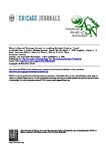When is general wariness favored in avoiding multiple predator types?
| dc.contributor.author | Brilot, BO | en |
| dc.contributor.author | Bateson, M | en |
| dc.contributor.author | Nettle, D | en |
| dc.contributor.author | Whittingham, MJ | en |
| dc.contributor.author | Read, JC | en |
| dc.date.accessioned | 2014-05-06T14:07:30Z | |
| dc.date.available | 2014-05-06T14:07:30Z | |
| dc.date.issued | 2012-06-06 | en |
| dc.identifier.uri | http://hdl.handle.net/10026.1/2996 | |
| dc.description | Free access to article and electronic appendices via DOI. | en |
| dc.description.abstract |
Adaptive responses to predation are generally studied assuming only one predator type exists, but most prey species are depredated by multiple types. When multiple types occur, the optimal antipredator response level may be determined solely by the probability of attack by the relevant predator: "specific responsiveness." Conversely, an increase in the probability of attack by one predator type might increase responsiveness to an alternative predator type: "general wariness." We formulate a mathematical model in which a prey animal perceives a cue providing information on the probability of two predator types being present. It can perform one of two evasive behaviors that vary in their suitability as a response to the "wrong" predator type. We show that general wariness is optimal when incorrect behavioral decisions have differential fitness costs. Counterintuitively, difficulty in discriminating between predator types does not favor general wariness. We predict that where responses to predator types are mutually exclusive (e.g., referential alarm-calling), specific responsiveness will occur; we suggest that prey generalize their defensive responses based on cue similarity due to an assumption of response utility; and we predict, with relevance to conservation, that habituation to human disturbance should generalize only to predators that elicit the same antipredator response as humans. | en |
| dc.format.extent | E180 - E195 | en |
| dc.language | eng | en |
| dc.language.iso | eng | en |
| dc.subject | Animals | en |
| dc.subject | Avoidance Learning | en |
| dc.subject | Behavior, Animal | en |
| dc.subject | Birds | en |
| dc.subject | Cats | en |
| dc.subject | Cues | en |
| dc.subject | Models, Biological | en |
| dc.title | When is general wariness favored in avoiding multiple predator types? | en |
| dc.type | Journal Article | |
| plymouth.author-url | http://www.ncbi.nlm.nih.gov/pubmed/22617270 | en |
| plymouth.issue | 6 | en |
| plymouth.volume | 179 | en |
| plymouth.journal | Am Nat | en |
| dc.identifier.doi | 10.1086/665648 | en |
| plymouth.organisational-group | /Plymouth | |
| plymouth.organisational-group | /Plymouth/Faculty of Science and Engineering | |
| plymouth.organisational-group | /Plymouth/REF 2021 Researchers by UoA | |
| plymouth.organisational-group | /Plymouth/REF 2021 Researchers by UoA/UoA04 Psychology, Psychiatry and Neuroscience | |
| dc.publisher.place | United States | en |
| dc.identifier.eissn | 1537-5323 | en |
| dc.rights.embargoperiod | Not known | en |
| rioxxterms.versionofrecord | 10.1086/665648 | en |
| rioxxterms.licenseref.uri | http://www.rioxx.net/licenses/all-rights-reserved | en |
| rioxxterms.type | Journal Article/Review | en |


